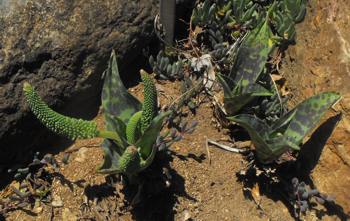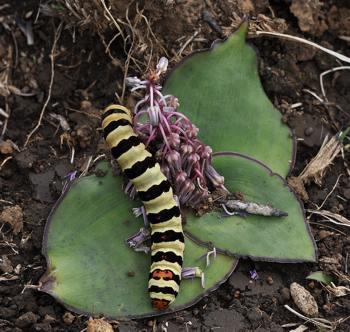Ledebouria zebrina
Ledebouria zebrina (Baker) S.Venter
Family: Hyacinthaceae
Common names: giant false scilla; giant African hyacinth
Introduction
This large attractive bulbous plant is the largest of all the ledebourias, the handsome broad leaves which are often marked with dark purple-brown spots and stripes are produced in summer following the masses of tiny scented greenish white flowers which are produced in early spring.

Description
Description
The giant false scilla is an attractive member of the Hyacinth family and produces large bulbs under the ground. In early spring the bulb is adorned with emergent leaves and masses of greenish white sweetly scented flowers on dense bottlebrush-like racemes which are held horizontal to the ground. The flowers attract a variety of insect visitors to pollinate them and collect the sweet nectar.

Large broad leaves develop to their full size after the flowers and can vary from completely unspotted to handsomely spotted and/or striped with dark purple brown to slate coloured markings. Completely unmarked populations are also known.
Conservation Status
Status
The species is widespread and reasonably common and therefore not currently listed as being threatened.
Distribution and habitat
Distribution description
Ledebouria zebrina is a widespread species over the northern provinces of southern Africa mostly on the eastern side including Eastern Cape, KwaZulu-Natal, Mpumalanga and Limpopo. The species occurs in low-lying grassland and mixed woodland.

Derivation of name and historical aspects
History
This species was first noted in scientific text in the late 1800s when it was initially thought to belong to the related genus Scilla and therefore named as Scilla zebrina (Baker). The species was subsequently included in a related species with which it was apparently confused for many years. It was only in 2008 when the name Ledebouria zebrina was finally correctly placed within the genus Ledebouria. The name Ledebouria is named in honour of the German-Estonian botanist Professor Carl Friedrich von Ledebour (1785-1851). The specific epithet, zebrina, is in reference to the striped leaf bases visible in many populations.
South Africa has 39 Ledebouria species of which L. zebrina is the largest of them all. The genus is distributed across Africa, India and Madagascar with the centre of species diversity in the eastern parts of southern Africa.
Ecology
Ecology
The giant false scilla has large broad leaves which may be plain green or often spotted or even striped. The exact reason for these markings is uncertain but it is thought that they play a role in camouflaging the plant from predators. If these markings are viewed with ultraviolet light, they appear black and therefore may look like holes in the leaves. This could give insect predators the illusion that leaves have already been eaten or are currently infested with other predators, thus warding off potential predation, however, this has not been properly studied.
Ledebourias are targeted by the larvae of the cherry spot moth (Diaphone eumela) as a larval food plant.

Uses
Use
The use of this species in traditional medicine in South Africa has not specifically been recorded, although the species has been identified in the traditional medicine trade where it may have been assumed to be the same as the widely used and superficially similar species Ledebouria revoluta.
The species can occasionally be seen in rockeries and gardens in ornamental horticulture although its use is still rare.
The following South African names have been applied to the related Ledebouria revoluta which is frequently used in traditional medicine: icubudwana, inqwebebane, ubuhlungu and bokhoe.
Similarly, the following name has been applied to the more distantly related yet commonly used Ledebouria ovatifolia : icubudwana.
Growing Ledebouria zebrina
Grow
This species, along with other ledebourias, is easily grown from seed and relatively quick growing; seedlings can reach full adult size in as little as three to four years.
Sow the seed in spring in a deep seed tray using a mixture of standard seedling mixture or sifted potting soil mixed with equal parts double washed and sifted river sand. Sow seed fresh (up to 1 year old) and cover with approximately 5 mm of the sifted mixture. Keep moist in a warm shaded position with adequate light until seedlings have germinated which may take two to four weeks, after which watering can be reduced slightly to reduce the chances of damping off.
Once seedlings are large enough to handle they can be transplanted into small pots or they can be left in the seed tray until the following spring before transplanting just as they begin to show signs of sprouting. Sub-adult plants can be planted out into the ground after they are about two years old. Plant in a well-drained sunny position and once established can be watered sparingly.
Ledebouria zebrina can be used to good effect in a succulent rockery where it can be planted between rocks or at the base of larger succulents such as aloes. The large bulb allows the species to withstand prolonged drought and ideally should be kept completely dry in winter.
If grown under ideal conditions the species is usually pest free. Occasionally they may get mealy bug in the crown and under the folds of the leaves, this is easily controlled by cleaning with an old toothbrush dipped in 10% methylated spirits mixed with water or by simply washing off with a hosepipe. The caterpillar of the cherry spot moth (Diaphone eumela) will on occasion eat the flowers or leaves. They are not usually a problem as they don't attack in great numbers and can often be left alone or simply removed by hand. The damage they do is inconsequential as they are not recorded to tunnel down into the bulb.
Acknowledgements
Dr Neil Crouch is thanked for assistance on ethnobotanical information.
References
- Hankey, A. 2003. Distinguishing between Ledebouria , Drimiopsis and Resnova . PlantLife 29: 38-39.
- http://www.ispot.org.za/search/node/Ledebouria
- http://www.ispot.org.za/search/node/Cherry%20spot%20moth
- Mulholland, D.A., Crouch, N.R., Koorbanally, C., Moodley, N. & Pohl, T. 2006. Infraspecific chemical variation in Scilla zebrina (Hyacinthaceae) . Biochemical Systematics and Ecology 34(3): 251-255.
- Venter, S. 2008. Synopsis of the Genus Ledebouria Roth (Hyacinthaceae) in South Africa . Herbertia 62.
Credits
Andrew Hankey & Refilwe Malatji
Walter Sisulu National Botanical Garden
November 2013
Plant Attributes:
Plant Type: Bulb
SA Distribution: Eastern Cape, KwaZulu-Natal, Limpopo, Mpumalanga
Soil type: Sandy, Loam
Flowering season: Spring, Early Summer
PH: Neutral
Flower colour: Green, White
Aspect: Full Sun
Gardening skill: Easy
Special Features:
Horticultural zones











Rate this article
Article well written and informative
Rate this plant
Is this an interesting plant?
Login to add your Comment
Back to topNot registered yet? Click here to register.